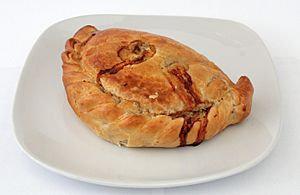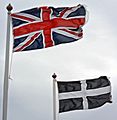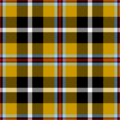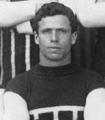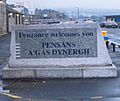Cornish people facts for kids
The Cornish people (also called Kernowyon) are a group of people connected to Cornwall. Cornwall is a region in the southwest of Great Britain, which is part of England. The Cornish are officially recognized as a national minority in the United Kingdom.
The Cornish people are a unique group in the UK. Their history goes back to the ancient Britons who lived in southern Great Britain before the Romans arrived. Many people in Cornwall today feel a strong connection to their Cornish identity, either instead of or in addition to being English or British.
People who have moved to Cornwall, as well as Cornish people who have moved to other countries and their descendants, also share this identity. Even though "Cornish" wasn't a specific option on the UK census form, the number of people who say they are Cornish is officially recorded.
In the 2011 census, about 532,300 people lived in Cornwall, including the Isles of Scilly. Groups like the Cornish self-government movement want more recognition for Cornish culture, politics, and language. They believe Cornish people should have a special status, like being listed as an ethnic group on the census form.
 |
|
| Total population | |
|---|---|
6–11 million worldwide
|
|
| Regions with significant populations | |
| 1,000,000 | |
| 1,000,000 – 2,500,000 | |
| Languages | |
| Religion | |
| Related ethnic groups | |
|
a Cornish American, b Cornish Australian |
|
Contents
Cornish History
During ancient times, different Celtic tribes lived in Great Britain. The Dumnonii and Cornovii were two Celtic tribes who lived in the area that became Cornwall. This was during the Iron Age, Roman, and post-Roman periods. The name Cornwall and the word "Cornish" come from the Cornovii tribe.
Traditional stories say that Cornish people are descended from the Celts. This makes them different from the English, many of whom came from the Anglo-Saxons. The Anglo-Saxons settled in Great Britain from northern Europe and pushed the Celts to the western and northern edges of Britain.
Where Cornish People Live Today
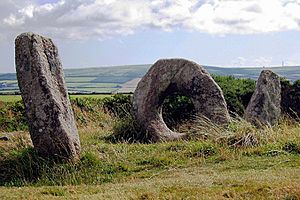
Most Cornish people live in Cornwall. However, after the Age of Discovery, many Cornish people moved to other parts of the world. They were involved in the British colonization of the Americas and other migrations across oceans. At first, not many people left Cornwall. Those who did often settled in North America or in ports and plantations in the Caribbean.
In the early 1800s, Cornish people were experts in tin and copper smelting. Mining in Cornwall was the main job for many people. But then, there was more competition from places like Australia and Bolivia. Also, the mineral deposits in Cornwall started to run out. This led to a big economic decline for Cornish mining that lasted for 50 years. It caused many people to leave Cornwall.
Between 1861 and 1901, about 20% of Cornish men moved abroad each decade. This was three times more than the average for England and Wales. In total, over 250,000 people left Cornwall between 1841 and 1901.
Skilled Cornish engineers, farmers, merchants, miners, and tradesmen moved away. Their skills, especially in hard rock mining, were highly valued in the new places they went. Within Great Britain, Cornish families also moved to North East England, especially to Teesside. They went there to work in coal mining, using their mining skills to earn money. Because of this, you can still find many Cornish family names in the Teesside area today.
Cornish People in Australia
From the start of Australia's colonial period until after World War II, most people coming to Australia were from the United Kingdom. This means many Australians today have British ancestors. Cornish people were especially encouraged to move to Australia after mining declined in Cornwall in the 1800s.
A strong campaign was started to get Cornish people to help with mining in Australia. This was because of their experience and skills. Hundreds of Cornish miners and their families were given free passage to South Australia. Because of this, a large Cornish community grew in Australia's Copper Coast. South Australia's Yorke Peninsula even became known as "Little Cornwall." It's thought that between 1837 and 1840, 15% of all people who received help to move to South Australia were Cornish.
Cornish People in Canada
Cornish people first came to what is now Canada in the 1500s. They were part of European fishing trips around Newfoundland. However, Cornish people didn't start settling permanently across the Atlantic Ocean until the 1800s. The British colonization of the Americas encouraged more Cornish people to move to Canada. This was especially true for those who served in Great Britain's Royal Navy. When the colony of British North America was created, even more people from Cornwall settled there. They were usually listed as English migrants.
Cornish People in Mexico
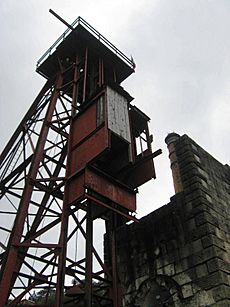
In 1825, a group of 60 Cornishmen left Falmouth for Mineral del Monte in central Mexico. They brought 1,500 tons of mining machinery with them. Their goal was to use their mining skills to restart Mexico's struggling silver mining industry. This industry had been neglected during the Mexican War of Independence.
After their sea journey, they tried to dock at Veracruz. But they were forced to a beach at Mocambo by the Spanish. From there, they had to pull their heavy machinery through jungles and swamps to Santa Fe.
During this difficult journey, many Cornishmen and their Mexican helpers got yellow fever. Thirty Cornish people and 100 Mexicans died. The sickness forced the survivors to leave their equipment behind. They headed inland up into the mountains to Xalapa to escape the mosquitoes for three months, until the rainy season ended. Once the rainy season was over, the Cornish and Mexican miners continued their 250-mile (400 km) "Great Trek" to Mineral del Monte. They carried their machinery to an altitude of 10,000 feet (3,000 m) above sea level. They finally arrived on May 1, 1826.
After they arrived, the Cornish community grew and stayed in central Mexico until the Mexican Revolution in 1910. Most of the Cornish community in Mexico eventually returned to Cornwall. However, they left behind a cultural legacy. Cornish pasties, Cornish mining museums, and a Cornish Mexican Cultural Society are all part of the local heritage and traditions in and around Mineral del Monte.
Cornish People in South Africa
The Witwatersrand Gold Rush in 1886 encouraged many Cornish miners to move to the South African Republic. Even though it was an international gold rush, Cornish people made up most of the skilled workers in the Witwatersrand. This continued until the Second Boer War started, which caused many to leave.
Cornish People in the United States
When lead ore and copper were discovered in North America, many Cornish miners moved to the continent. They especially settled around the Upper Mississippi River. By the early 1800s, Cornish people were living in the Upper Peninsula of Michigan, particularly in the mining town of Ishpeming. More Cornish migrants came after the California Gold Rush in the mid-1800s. In the 1890s, it was estimated that over 60% of the population in California's Grass Valley was Cornish.
Most Cornish people who moved to the United States were listed as English or British. This makes it hard to know the exact number of Cornish Americans. However, it's thought that about 100,000 people from Cornwall moved to the United States before World War I.
Cornish Food
Cornish food is a regional type of British cuisine. It uses many local ingredients to create fairly simple dishes. The most famous Cornish food is the pasty (sometimes called the Cornish pasty). It is made from diced beef, potato, onion, and swede (which Cornish people often call 'turnip'). These ingredients are wrapped in a pastry crust and then baked. One idea about its origin is that it was a portable lunch for Cornish miners. The thick crust could be held by a miner's dirty hands without touching the filling, and then thrown away.
Fish was also a very important part of the Cornish diet. By the 1500s, international commercial fishing was well-established. Tons of pilchards were sent from Cornwall to France, Italy, and Spain every year. Stargazy pie is a special Cornish dish sometimes eaten at festivals. It has fish heads (originally pilchards) sticking out of a pastry crust. The saffron bun, also known as the tea treat bun, is a sweet bread that also started in Cornwall.
Images for kids
-
The Union and Cornish flags.
-
A poster in Cornwall telling people how to describe their ethnicity and national identity as Cornish in the 2011 census
-
An 18th century map of Great Britain based on accounts from the Anglo-Saxon Chronicle, showing "Cornweallas"
-
European nations in AD 998
-
The National Tartan of Cornwall. Cornish kilts and tartans are symbols of a growing, pan-Celtic Cornish identity that developed during Cornwall's Celtic Revival.
-
Cornish miners in the mid-19th century. A decline in mining in Cornwall led to many Cornish miners and families moving away, creating a Cornish diaspora.
-
William "Harold" Oliver was the son of Australian Cornish immigrants who lived in the mining town of Waukaringa. Harold Oliver was a three time national champion with the Port Adelaide Football Club in 1910, 1913 and 1914.
-
The 'Obby 'Oss festival is a Cornish May Day festival celebrated in Padstow.
See also
 In Spanish: Pueblo córnico para niños
In Spanish: Pueblo córnico para niños


